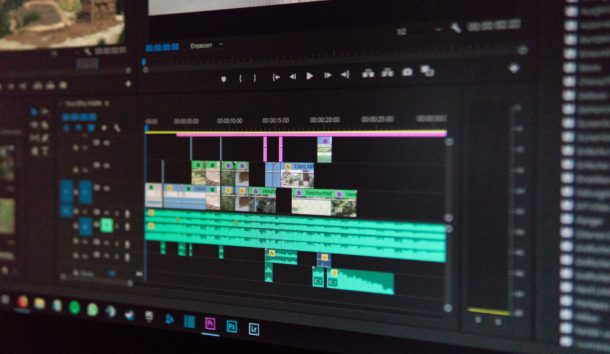When working with audio and video content you will come across many different file formats, including MP4, AVI, OGG, and WEBM. Knowing which file format to use and when to use it will separate you from the average user. In this article, we will dive into some of the different audio and video file formats and when to use them so that you can make the right decision.
But before that, let’s go over a few things:
What is a video file format?

Video file formats are essential for two primary reasons.
First, they help determine the final size of your video file. With video resolution increasing by the day, the file size also grows, therefore, requiring that you select the right format. So, keep in mind that the format you pick will largely determine how small or large the final video file will be.
Second, videos have many different parts that need to be put together into the final package. These parts include the actual video portion, audio streams, and additional information such as metadata, optional subtitles, etc., all of which must work together. There is also a container that bundles everything together and ensures your video works with whatever video player you have and a codec that compresses and decompresses your video. Both the container and codec result in the video file format.
Codecs
A codec is what compresses and decompresses a video file. The compression can be either lossy or lossless. Lossy compression creates smaller file sizes, but leaves out some of the integral data resulting in a lower video quality. This is particularly evident after recurrent compressions that result in a progressive loss of substantial amounts of data.
Lossless compression, on the other hand, keeps all of the data from the original file. That gives you higher video quality and prevents continuous degradation from multiple saves. However, note that you will end up with larger files.
Tip! Not all codecs are compatible with all video players. So, when choosing a codec make sure to consider compatibility and the compromise between file size and video quality.
Video Containers
A video container is like a box that bundles and stores all of the elements of a video into a single package. These elements include the video itself, audio streams, video metadata, subtitles, the codec, etc.
Each video container type is compatible with particular video codecs. Your video editing software should only allow you to choose compatible pairings. You should try to plan which codec and container you want to use in advance to avoid running into issues when you render the final video.
Which file format is my video file?

Do this on windows to check your video file format:
- Right-click the file
- Click “Properties”
- Under the “Details” tab you will see the file format and codecs used
Do this on Mac:
- Right-click the video file
- Click “Get Info”
- Then under “More Info,” you will see both the video and audio codec
Which video format is the smallest?
So far, the HEVC or H.265 codec is known to be one of the most efficient and smallest file formats available on the market. It is commonly used to compress 8K UHD video. However, it is worth noting that using this codec requires paying a licensing fee and that is why it is not widely compatible or supported by browsers or devices. On the web, WEBM and its matching VP8/VP9 codec are highly compatible with browsers and therefore a popular way of making video files smaller.
Popular video file formats
.WEBM
This is an open, royalty-free, media file format designed for the web. This format is used for HTML5 video streaming websites such as YouTube. Google created it as an efficient means of disseminating media to a large audience. This video file is relatively small in size, and for this reason, not high in terms of quality compared to other file types on this list.
.OGG
.OGG is used for high-quality videos to be streamed via the internet. They are an open-source alternative to .MPG files and are higher in quality than .WEBM files. That means they will take longer to be delivered to the end-user. Since they are open-source, they can be used in multiple applications, including media players and GPS receivers.
.AVI
.AVI files are very flexible in choosing a balance between size and quality. Many different codecs can be used with this format. However, they tend to be larger than most formats, making it less suitable for the web and more appropriate for storing movies on a computer.
.AVI files are among the oldest and most compatible video file formats and that is why they are used with many different codecs.
AVCHD
Advanced Video Coding High Definition files (AVCHD) are the format generated by many digital camcorders. They use the H.264/MPEG-4 video codec and are similar to an .MPG file.
This format is used for HD video playback and digital recording and was designed by Panasonic and Sony for professional high definition video recording.
This format also allows you to store lengthy high-quality video using only a small amount of data by leveraging the H.264/MPEG-4 video compression technology. Moreover, the latest version of the format AVCHD 2.0 supports 3-D video.
.MPG, .MP2, .MPEG, .MPE, .MPV
These files can play audio/video media. They are low in file size and also relatively low in quality. Plus, they have lossy compression, which is why they are recommended for videos recorded once and never edited.
.MOV, .QT
These two files were developed by Apple to use with its QuickTime player. They are of high quality, but large in size. This format is ideal if you intend to achieve a high-quality video on an Apple computer. This is because they have poor compatibility with non-QuickTime players.
MOV files contain audio, video, timecodes, subtitles, and other media types. It is compatible across different versions of QuickTime Player, both for Windows and Mac. Because it is a very high-quality video format, MOV files take significantly more memory space on a computer.
.MP4, .M4P, .M4V
These files can contain audio and video or can simply be exclusively audio files. They are used for streaming video via the internet and are generally higher in quality than .WEBM files, however, tend to be larger in file size. They are lossless, making them suitable for editing as their quality won’t degrade with subsequent edits and saves.
.M4V files are proprietary iTunes files that share the same qualities of .MP4 and M4V files .M4P files. And are DRM copy-protected.
MKV
MKV file format incorporates video, audio, and subtitles in a single file. This format was developed to be future proof, meaning that they will always stay up-to-date. MKV containers support almost any audio and video format, making them highly adaptive and easy to use.
.WMV
Microsoft also creates this file format. It stands for Windows Media Video, and the codec used by these files results in small, poor quality file sizes. This format is ideal if sending video to someone with an older Windows computer.
WMV’s small file sizes are better than those of MP4, and that is why it is popular for online video streaming. Though it is not compatible with Apple devices, users can download Windows Media Player for their iPhone or Mac.
.FLV, .SWF
Adobe designed these two files as the video file format for Flash. Over the years, the use of these file formats has declined as Flash has become less popular. These formats are currently only suggested if you need to support a legacy system that can only accept this type of file.
How to select the best video file format

Selecting the right video file format depends entirely on what you plan on using the video for. You should only pick a format that achieves the quality of video you require, nothing more. Needlessly high-quality video files can be cumbersome to share, convert, move, and manage. Besides, how the video files will be viewed is essential. This is because some programs, browsers, and devices can’t open specific video formats. For example, if your video will be viewed on the web, pick a format supported by most browsers. That way, your video will be played without downloading.
On the other hand, if archiving a home video, select a high-quality format with a good chance of being playable in the future. Open source formats (like MP4 and AVI) come in handy here as they are more future-proof than proprietary formats controlled by specific companies.
If working at a company that uses older Windows computers, select a format that is highly compressed and compatible with Windows. A WMV file is a good option here.
Which is the best video format?

Regrettably, there is no single video format that can be said to be the “best” of all. The best video format for you largely depends on how you would like to balance the video file’s quality and size. Some formats are extremely small and are suitable for web streaming, but are of low quality. Other formats are high quality and the right choice for commercial videography, but are very large in size.
Conclusion
As you have seen, there are different video file formats. Some suitable for smaller videos, and others fit for large videos. Hope we have made it easier for you to choose the right file format. If you still have a question, let us know in the comments.

